Seagate has been releasing NAS drives of various types for years. While they mainly focus on Hard Drives, Seagate has slowly but steadily increased their SSD portfolio. For NAS drives, it all falls under the IronWolf umbrella now with several options. There is the high capacity IronWolf HDDs now up to 18TB, M.2 SSDs for SSD cache without giving up capacity, IronWolf 110 2.5” SATA SSDs for better overall performance and good endurance, and now the Seagate IronWolf 125 for even better performance for a lower price.
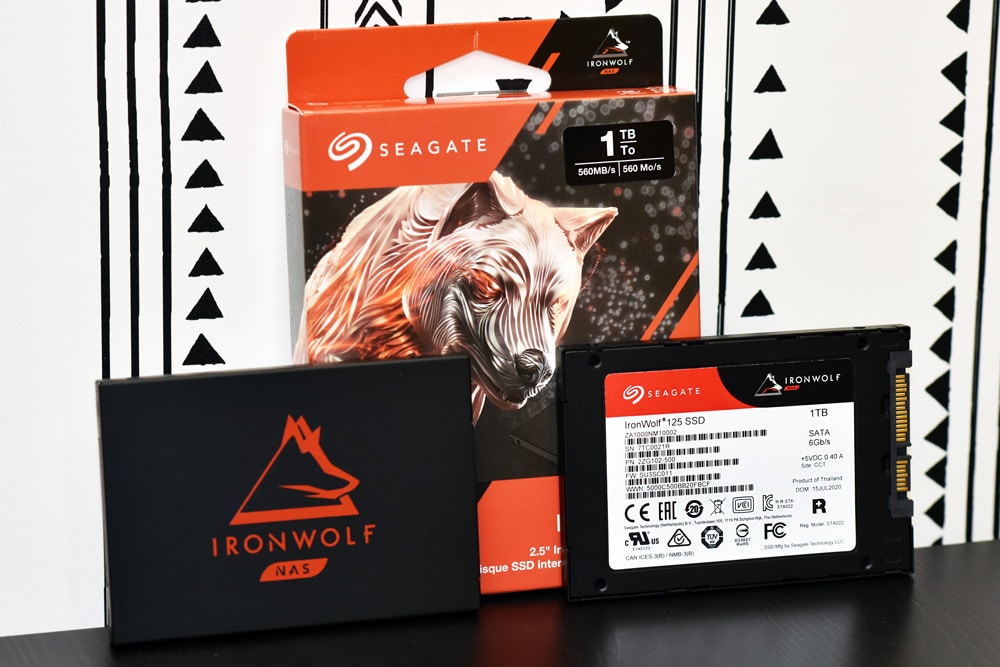
As stated, there is a Seagate IronWolf 2.5” SATA SSD already out there, the 110, in fact, we reviewed it here. The 110 was the first SSD to be NAS specific from the company. The Seagate IronWolf 125 is the next step up and is said to be a NAS-optimized drive that delivers 24×7 endurance and multi-user scalable performance to meet the needs of SMBs, creative professionals, and home office users. Like other IronWolf drives, the 125 has a five-year limited warranty and a three-year Seagate Rescue Data Recovery Service. The endurance is a bit lighter than the 110 but promises overall better performance.
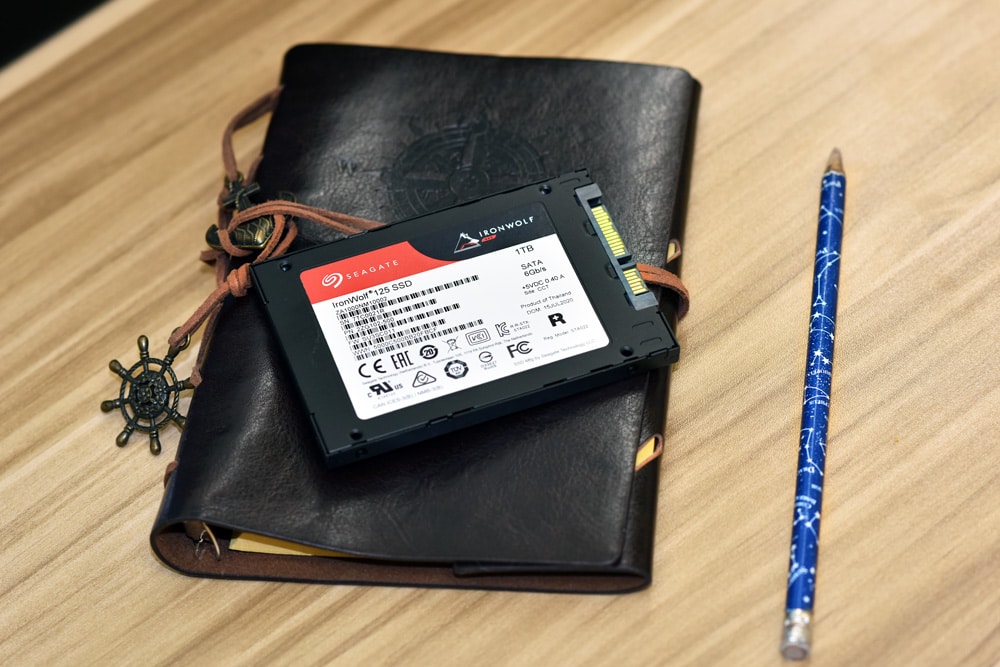
The Seagate IronWolf 125 SSDs come in capacities from 250GB all the way up to 4TB and can be picked up today starting at $60 for the 250GB and up to $609 for the 4TB. For our review, we will be looking at the 4TB.
Seagate IronWolf 125 Specifications
| Capacity | 4TB | 2TB | 1TB | 500GB | 250GB |
| Standard Model | Z A4000N M 10002 | Z A2000N M 10002 | Z A1000N M 10002 | Z A500N M 10002 | Z A250N M 10002 |
| Features | |||||
| Interface | SATA 6Gb/s | SATA 6Gb/s | SATA 6Gb/s | SATA 6Gb/s | SATA 6Gb/s |
| NAND Flash Type | 3D TLC | 3D TLC | 3D TLC | 3D TLC | 3D TLC |
| Form Factor | 2.5 in × 7mm | 2.5 in × 7mm | 2.5 in × 7mm | 2.5 in × 7mm | 2.5 in × 7mm |
| Performance | |||||
| Sequential Read (Max, MB/s), 128KB QD32 | 560 | 560 | 560 | 560 | 560 |
| Sequential Write (Max, MB/s), 128KB QD32 | 540 | 540 | 540 | 540 | 540 |
| Random Read (Max, IOPS), 4KB QD32 | 95,000 | 95,000 | 95,000 | 95,000 | 95,000 |
| Random Write (Max, IOPS), 4KB QD32 | 90,000 | 90,000 | 90,000 | 90,000 | 90,000 |
| Endurance/Reliability | |||||
| Total Bytes Written (TB) | 5600 | 2800 | 1400 | 700 | 300 |
| Nonrecoverable Read Errors per Bits Read | 1 per 10E17 | 1 per 10E17 | 1 per 10E17 | 1 per 10E17 | 1 per 10E17 |
| Mean Time Between Failures (MTBF, hours) | 1,800,000 | 1,800,000 | 1,800,000 | 1,800,000 | 1,800,000 |
| Warranty, Limited (years) | 5 | 5 | 5 | 5 | 5 |
| Power Management | |||||
| Power Supply | 5V | 5V | 5V | 5V | 5V |
| +5 Active Max Average Power (W) | 2.8 | 2.6 | 2.4 | 2.3 | 2.3 |
| Average Idle Power (mW) | 140 | 140 | 130 | 115 | 110 |
| DevSleep (mW) | 5 | 5 | 5 | 5 | 5 |
| Environmental | |||||
| Temperature, Operating Internal (°C) | 0 to 70 | 0 to 70 | 0 to 70 | 0 to 70 | 0 to 70 |
| Temperature, Nonoperating (°C) | –40 to 85 | –40 to 85 | –40 to 85 | –40 to 85 | –40 to 85 |
| Shock, Nonoperating: 0.5ms (Gs) | 1500 | 1500 | 1500 | 1500 | 1500 |
| Physical | |||||
| Height (mm/in, max) | 7.10mm/0.279in | 7.10mm/0.279in | 7.10mm/0.279in | 7.10mm/0.279in | 7.10mm/0.279in |
| Width (mm/in, max) | 70.10mm/2.759in | 70.10mm/2.759in | 70.10mm/2.759in | 70.10mm/2.759in | 70.10mm/2.759in |
| Depth (mm/in, max) | 100.35mm/3.950in | 100.35mm/3.950in | 100.35mm/3.950in | 100.35mm/3.950in | 100.35mm/3.950in |
| Weight (g/lb) | 50g/0.110lb | 50g/0.110lb | 50g/0.110lb | 50g/0.110lb | 50g/0.110lb |
Seagate IronWolf Pro 125 SSD Performance
In this review, we look at 4 drives in a RAID5 configuration inside our QNAP TS-1685 for testing. We use our Dell PowerEdge R730 with a Windows S2012 R2 VM as an FIO load generator.
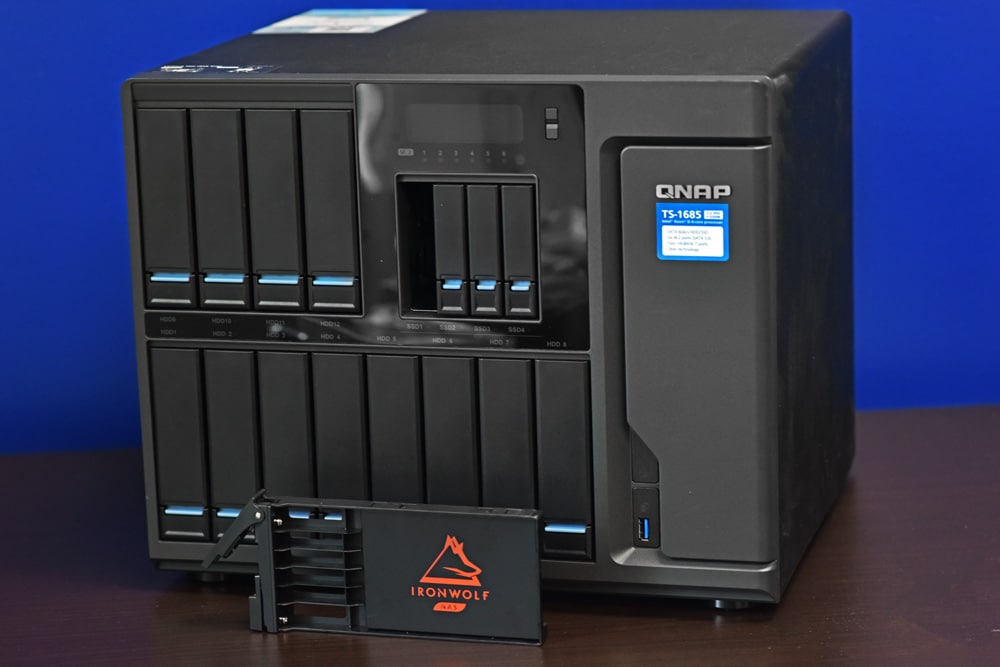
Enterprise Synthetic Workload Analysis
Our enterprise drive benchmark process preconditions each drive-set into steady-state with the same workload the device will be tested with under a heavy load of 16 threads, with an outstanding queue of 16 per thread. The device is then tested in set intervals in multiple thread/queue depth profiles to show performance under light and heavy usage. Since NAS storage reaches their rated performance level very quickly, we only graph out the main sections of each test.
Preconditioning and Primary Steady-State Tests:
- Throughput (Read+Write IOPS Aggregate)
- Average Latency (Read+Write Latency Averaged Together)
- Max Latency (Peak Read or Write Latency)
- Latency Standard Deviation (Read+Write Standard Deviation Averaged Together)
Our Enterprise Synthetic Workload Analysis includes four profiles based on real-world tasks. These profiles have been developed to make it easier to compare to our past benchmarks, as well as widely-published values such as max 4K read and write speed and 8K 70/30, which is commonly used for enterprise drives.
- 4K
-
- 100% Read or 100% Write
- 100% 4K
- 8K 70/30
- 70% Read, 30% Write
- 100% 8K
- 128K (Sequential)
- 100% Read or 100% Write
- 100% 128K
Looking at our throughput test which measures 4K random performance the Seagate IronWolf 125 was able to hit 262,040 IOPS read in iSCSI and 53,603 IOPS read in SMB. In write, the drive gave us 72,788 IOPS in iSCSI and 38,058 IOPS in SMB.
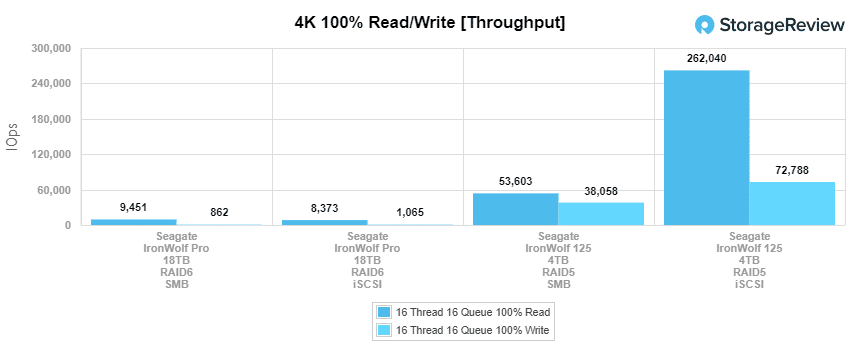
Next, we look at 4K average latency where the drive had only 976µs in iSCSI read and 3.51ms in iSCSI write. For SMB we saw a read of 4.77ms and a write of 6.72ms.
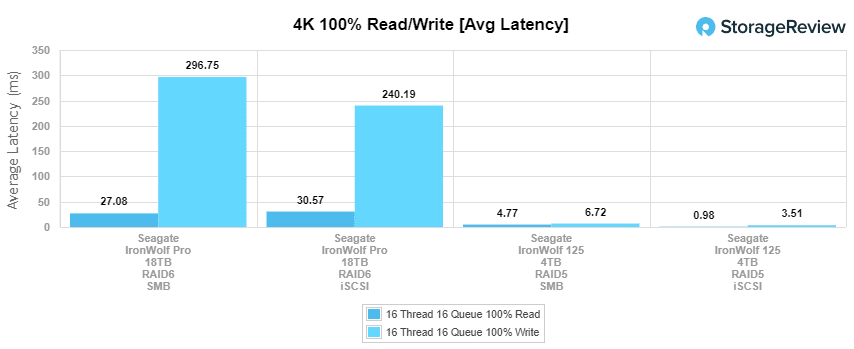
With 4K max latency, the NAS SSD had iSCSI speeds of 357.1ms read and 40.8ms write. With SMB we saw 35.1ms read and 27ms write.
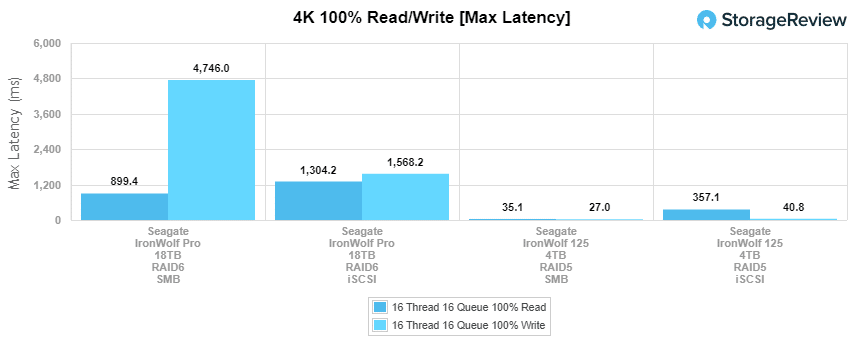
Our last 4K test was standard deviation giving us iSCSI speeds of 1.02ms read and 4.81ms write. SMB scores were 3.19ms read and 4.69ms write.
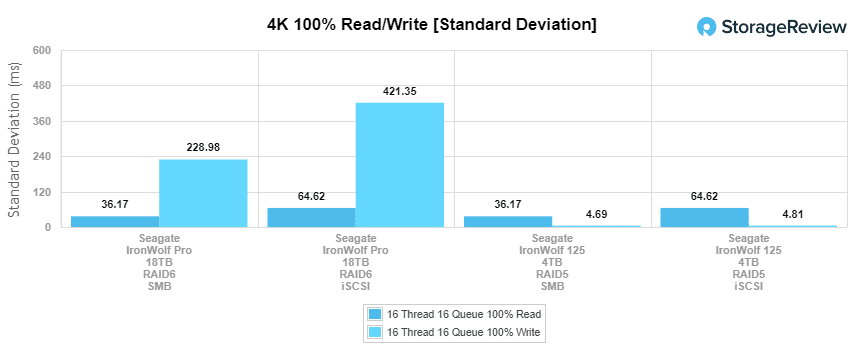
The next benchmark tests the drives under 100% read/write activity, but this time at 8K sequential throughput. In iSCSI, the Seagate IronWolf 125 had 218,619 IOPS read and 140,402 IOPS write. In SMB we saw 52,333 IOPS read and 42,932 IOPS write.
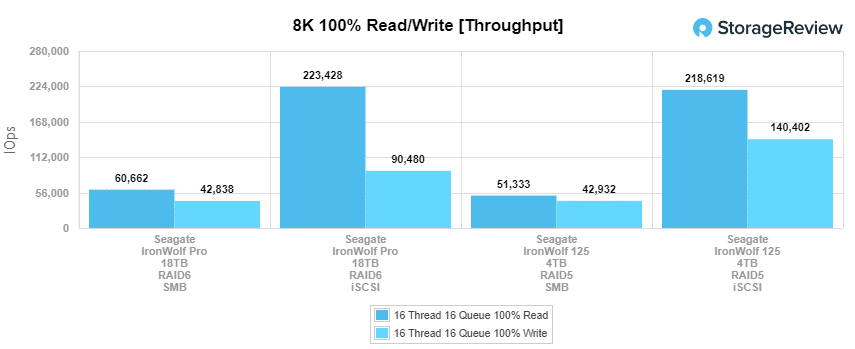
Our next test shifts focus from a pure 8K sequential 100% read/write scenario to a mixed 8K 70/30 workload, which will demonstrate how performance scales in a setting from 2T/2Q up to 16T/16Q. In SMB, the Seagate SSD went from 16,210 IOPS up to a peak of 26,633 IOPS before dropping off a bit. In iSCSI, the drive went from 10,465 IOPS to 92,299 IOPS before dropping off some.
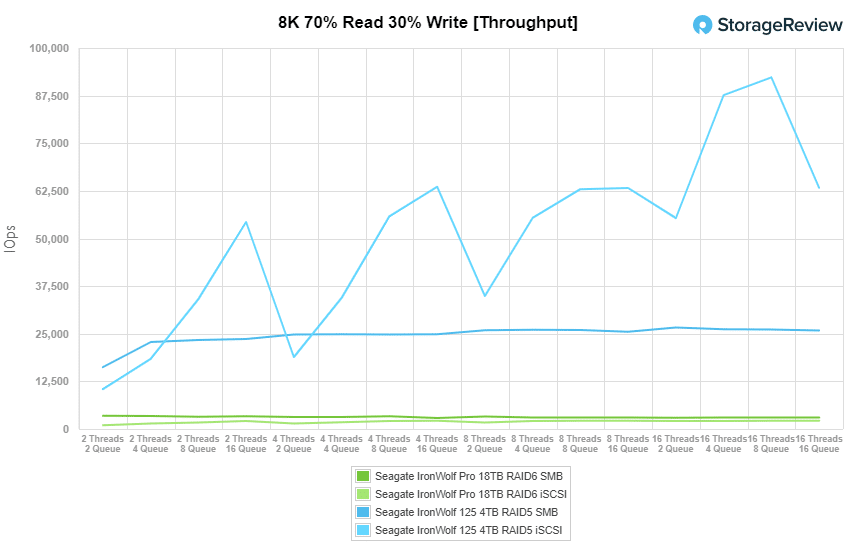
In 8K 70/30 Average latency we saw a range of 240µs to 9.9ms for SMB and 380µs to 4.04ms for iSCSI.
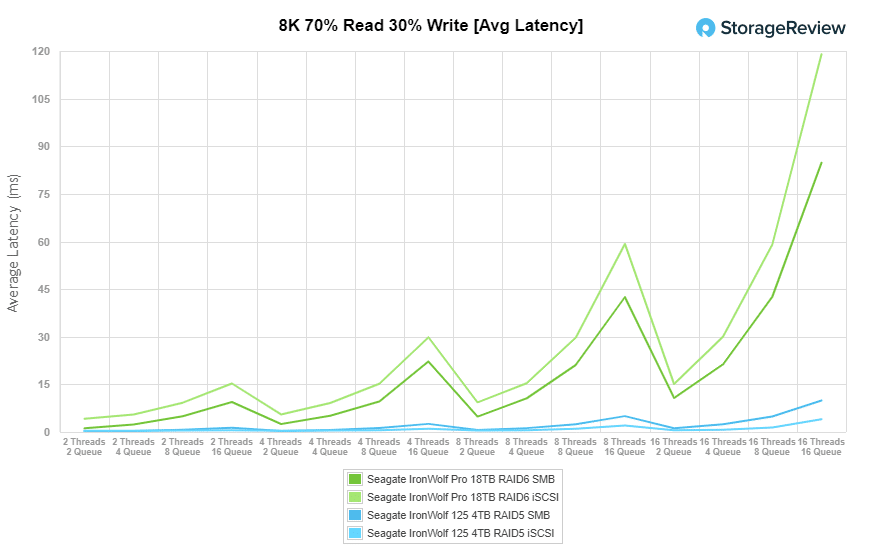
8K 70/30 Max latency had the drive range from 10ms to 24.72ms in SMB and a high start of 34.06ms to 39.26ms in iSCSI, with a dip in the middle.
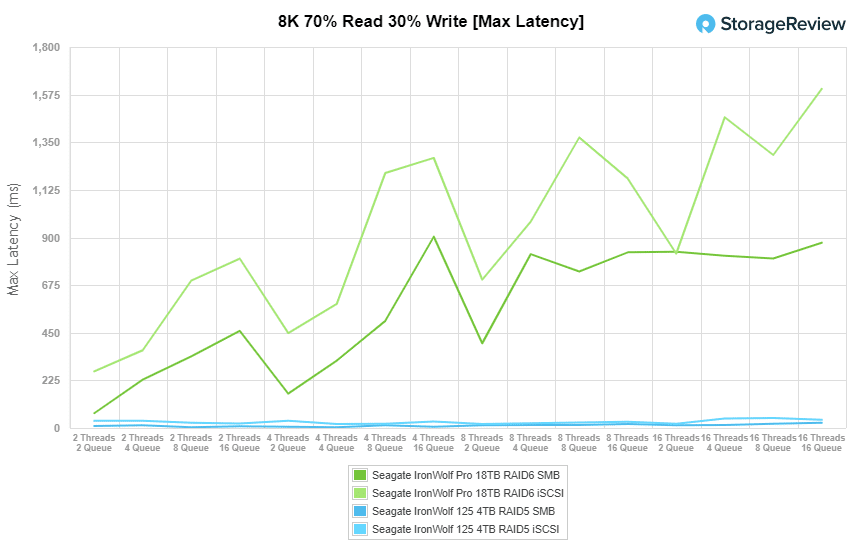
Our last 8K 70/30 test was standard deviation where the drive went from 60µs to 570µs in SMB and 320µs to 5.68ms in iSCSI.
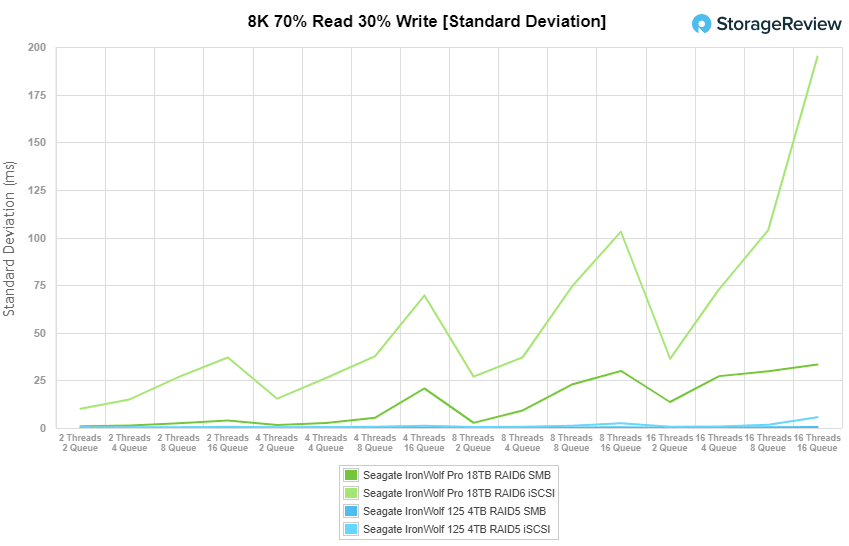
Our last test is the 128K benchmark, which is a large-block sequential test that shows the highest sequential transfer speed. Here, the SSD hit 1.93GB/s read and 1.98GB/s write in iSCSI and 2.31GB/s read and 1.66GB/s write in SMB.
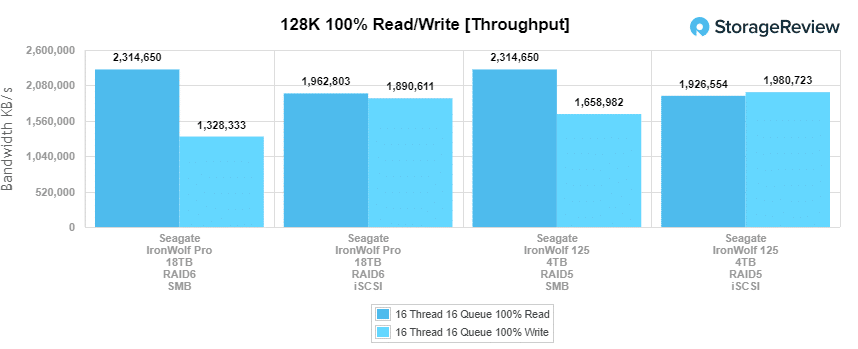
Conclusion
The Seagate IronWolf 125 is an SSD designed specifically for NAS use. In fact, the drive has been optimized for NAS where multi-users are present. The drive is a big step up in performance from the 110 but trades some endurance for it. The 125 comes in capacity up to 4TB and has a five-year limited warranty and a three-year Seagate Rescue Data Recovery Service.
For performance, we ran our typical NAS benchmarks in our QNAP TS-1685. The drive offered very impressive performance for a SATA SSD. Our 4K tests saw a high of 262K IOPS read and 73K IOPS write, both in iSCSI. In 4K average latency the drive had 976µs read and 3.51ms write again in iSCSI. For 4K max latency the SSD hit 35.1ms read and 27ms write in SMB. 4K Standard Deviation saw latency of 1.02ms read (iSCSI) and 4.69ms (SMB). 8K 100% sequential saw highs of 219K IOPS read and 140K IOPS write in iSCSI. Large block sequential 128K had speeds of 2.31GB/s read (SMB) and 1.98GB/s write (iSCSI). Sequential performance while strong, still comes in at or below where hard drives perform, making these drives fit best in situations where random-access workloads come up.
The Seagate IronWolf 125 is an impressive NAS specific SATA SSD. It hit very good numbers in our benchmarks (particularly in iSCSI configuration) and it has a reasonable price. If you need a bump in performance in your NAS and don’t mind a small drop in endurance, the Seagate IronWolf 125 can do, with a good price point as well.




 Amazon
Amazon